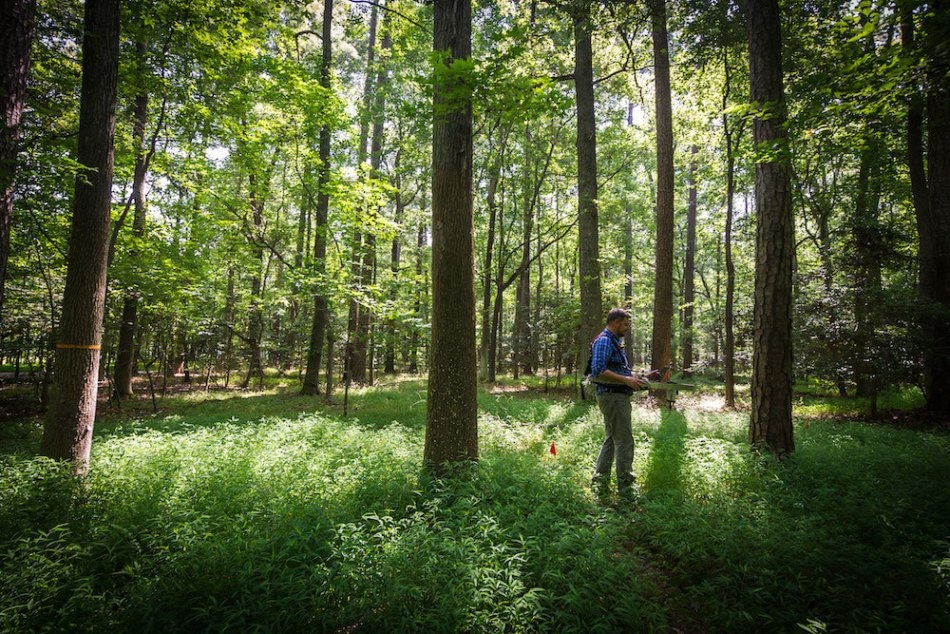Aug 13 2019
According to a new study headed by scientists at Virginia Commonwealth University (VCU), structurally complex forests in the eastern United States sequester more carbon. In other words, the vegetation arrangement is extremely varied.
 Jeff W. Atkins, Ph.D., a post-doctoral researcher in VCU’s Department of Biology, uses a LIDAR system to collect data in a forest at VCU’s Rice Rivers Center in 2016. (Image credit: Julia Rendleman, University Marketing)
Jeff W. Atkins, Ph.D., a post-doctoral researcher in VCU’s Department of Biology, uses a LIDAR system to collect data in a forest at VCU’s Rice Rivers Center in 2016. (Image credit: Julia Rendleman, University Marketing)
For the first time, the study showed that the structural complexity of a forest is a better predictor of carbon sequestration potential when compared to the diversity of tree species. This latest finding may have implications for the mitigation of climate change.
Carbon dioxide, a potent greenhouse gas, is taken up by trees through the process of photosynthesis and some of that ‘fixed’ carbon is allocated to wood. Our study shows that more complex forests are better at taking up and sequestering carbon in wood and, in doing so, they leave less carbon dioxide in the air.
Chris Gough, PhD, Study Corresponding Author, and Associate Professor, Department of Biology, College of Humanities and Sciences
The study titled, “High Rates of Primary Production in Structurally Complex Forests,” will be reported in the upcoming issue of Ecology—a journal of the Ecological Society of America.
Carbon sequestration can be described as a process through which the carbon dioxide in the atmosphere is taken up by grasses, trees, and other kinds of plants via photosynthesis and then stored as carbon in plant and soil biomass, like roots, foliage, branches, and tree trunks.
According to the Forest Service of the U.S. Department of Agriculture, carbon sequestration in wood and forests helps offset sources of carbon dioxide to the air or atmosphere, like fossil-fuel emissions, forest fires, and deforestation.
It is not known why structurally complex forests are better at carbon sequestration. According to Gough, numerous layers of leaves may improve the way light is efficiently utilized to drive carbon sequestration in wood.
“In other words, forests that are structurally variable and contain multiple layers of leaves outperform structurally simple forests with a single concentrated band of vegetation,” he stated.
To perform the study, the scientists utilized a combination of their own data, and also data from the National Ecological Observatory Network (NEON), which is backed by the National Science Foundation.
NEON is creating long-term, publicly available data for diverse ecosystems in the United States, intending to figure out decades long ecological processes.
Jeff Atkins, PhD and biology post-doctoral scholar at VCU, headed field data collection along with scientists from Purdue University and the University of Connecticut serving as co-authors and collaborators.
Interpreting how the structure of forests powers carbon sequestration is significant for forest managers, climate modelers, and ecologists.
“Many of the ecological indicators of forest growth and carbon sequestration fail to explicitly account for complexity,” Gough stated. “We wanted to test whether more novel indicators of structural complexity are superior predictors of carbon sequestration in wood. We also wanted to know whether these predictors extend to a number of different forest types residing in various parts of the eastern half of U.S., from Florida to New Hampshire to Wisconsin.”
The research builds on earlier studies supported by the National Science Foundation that showed how LIDAR—a laser-based technology—maps the distribution of leaves within a forest canopy at extremely high resolution.
According to the latest study, using LIDAR technology to map the structure of forests could better predict their potential to sequester carbon in biomass when compared to traditional techniques that characterize leaf quantity and biodiversity.
This could be a major advance because we can likely use aircraft and, just in the last year, satellite data to collect the data needed to predict carbon sequestration from structural complexity. If we can estimate structural complexity from satellites in the future, then it may be possible to greatly improve our capacity to estimate and predict global forest carbon sequestration.
Chris Gough, PhD, Study Corresponding Author, and Associate Professor, Department of Biology, College of Humanities and Sciences
The results of the study demonstrate what ecologists can do when they implement innovative technologies and apply them to significant questions like: What impacts carbon sequestration and forest growth?
“These results, we hope, push the science forward by showing that how a forest is put together matters for carbon sequestration,” Gough stated. “And this relationship extends broadly to a number of different forests, from evergreen to deciduous and mid-Atlantic to Midwest.”
While the scientists discovered that structural complexity is a better predictor of carbon sequestration than species diversity measures, they observed that diversity is equally vital as one of many components that establish how structurally complex a forest is.
“We think structural complexity measures are powerful because they integrate multiple features of a forest that are critical to carbon sequestration,” said Gough. “It takes tree diversity to produce a variety of leaf and plant shapes and, additionally, a critical quantity of leaves to supply the building blocks required to assemble a structurally complex forest capable of sequestering lots of carbon.”
Apart from Gough, the paper was authored by Atkins, Robert T. Fahey, PhD, an assistant professor of forest ecology and management at the University of Connecticut, and Brady S. Hardiman, Ph.D., an assistant professor of urban ecology at Purdue University.